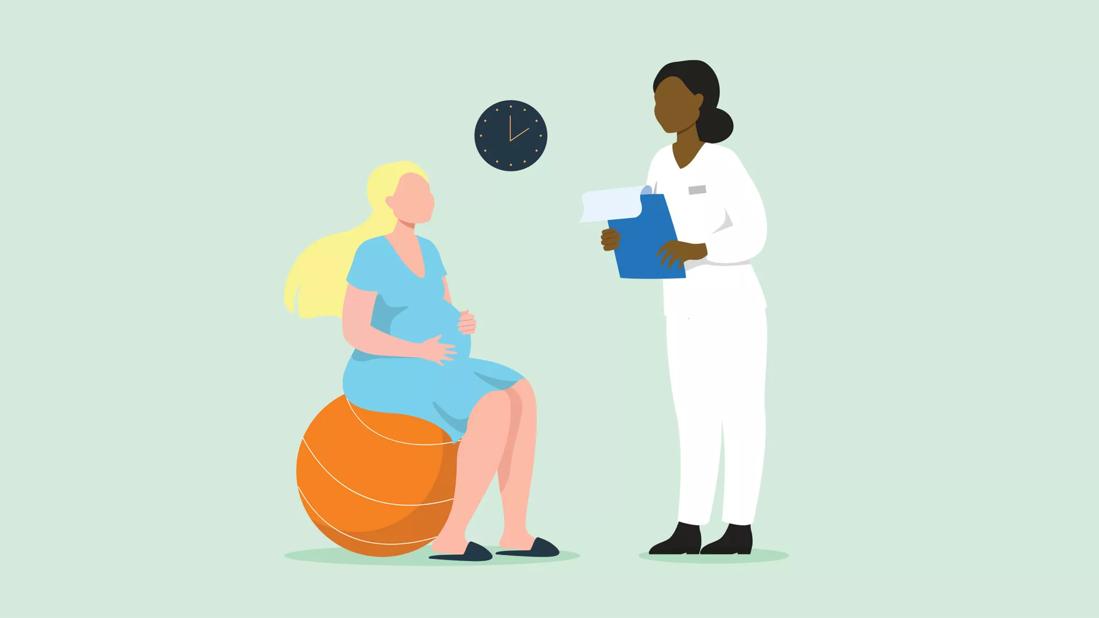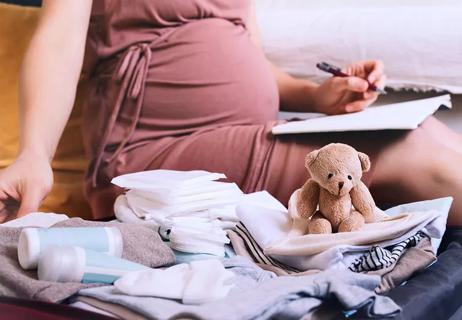Use relaxation techniques and breathwork to help manage the discomforts of a medication-free birth

Women have been giving birth for a long, long, long time. And until the 1900s or so, most births happened in homes, not hospitals. Without pain medicine, epidurals or even doctors.
Advertisement
Cleveland Clinic is a non-profit academic medical center. Advertising on our site helps support our mission. We do not endorse non-Cleveland Clinic products or services. Policy
A lot has changed.
A 2018 study suggests that epidurals, or spinal anesthesia, are used in about 71% of vaginal births in the United States.
It’s no secret that labor and delivery can be painful. And some women go into labor with a birth plan that includes a preference to use pain medicine, epidurals and other medical interventions to deal with the discomforts. And that’s fine.
But some women prefer not to use those options. That’s OK, too. And even if you opt for a natural birth, there are nonmedical options that can lessen the discomforts of labor and delivery.
“There are many ways to decrease pain in labor without the use of medications,” says childbirth educator Karen Spreng, RN, FACCE, LCCE. “Medication in labor has become more mainstream, but for those who want a natural birth, there are effective comfort measures to lower the discomfort of contractions.”
Spreng offers advice for women planning a natural birth.
For our purposes, when we’re talking about “natural birth,” we’re talking about a vaginal birth free from medical interventions like pain medications or epidurals.
Some people (and publications like The New York Times) prefer other language to describe this. You may also see natural birth referred to instead as “medication-free birth” or “unmedicated birth.”
Advertisement
There are a few reasons for that. One is that some people will refer to any vaginal birth as a “natural birth,” regardless of any medical interventions used or not used. So, using words like “medication-free birth” helps add clarity.
Others prefer terms like “medication-free birth” because by proclaiming one way of having a baby as “natural,” it could imply other ways of giving birth — like C-sections or medication-assisted vaginal births — are somehow inferior. (Which we know not to be the case.)
Because we know language resonates differently with different people, we’ll use a combination of these terms throughout this story. But know that throughout, we’re talking about a birth that happens with minimal medical interventions.
“Natural childbirth utilizes nonmedical comfort measures such as relaxation, labor support, positioning, movement, massage, hydrotherapy, aromatherapy, breathing, music and the use of the birth ball or peanut ball,” Spreng explains.
Some women have medication-free births at home. Others happen in hospitals or birthing centers. Some may have a midwife deliver their baby. Others have an Ob/Gyn.
“Natural birth isn’t about where the birth happens or who’s present for the birth,” Spreng clarifies. “It’s about not using medical interventions to manage pain during labor and delivery.”
Some choose a medication-free birth. In other cases, unmedicated births can happen because labor progresses quickly and there’s not enough time for medication. And some women may be advised against medical pain relief during labor because of certain health conditions.
Women have all kinds of reasons for why they choose to give birth without medication. Just as other women have reasons for opting for medical pain relief.
As long as your preference doesn’t put you or your baby in danger, neither is necessarily better than the other. But some studies have suggested that medication-free birth may have some benefits like:
Choosing a medication-free birth doesn’t mean resigning yourself to misery.
Yes, childbirth can be a tough task. But with the right support, mindset and preparation, many women cope with the discomforts of childbirth without medication. And knowing what to expect will help, too.
“Taking childbirth education classes, whether your goal is an unmedicated labor and birth or a medicated one, is very helpful. Knowledge of the process can help decrease stress, anxiety and fear,” Spreng says.
Advertisement
Spreng shares some techniques to help you prepare for a medication-free birth.
Assigning a labor support person gives you peace of mind and a helping hand when you need it. Your labor support person can take on many roles during labor. They can provide support by:
“During labor, you may find that your sensitivity to touch may change throughout the process. Labor support needs to be sensitive to those changes as labor progresses,” Spreng explains.
Your labor support person can be anyone you choose, including a partner, family member, friend, birth assistant (doula) or clinical caregiver.
“Whoever you choose as your labor support person (or labor support people) should be prepared to help you during labor and delivery however you need it,” she continues. “It’s helpful, too, if that person joins you for child birthing classes and understands your birth plan well. They should be your advocate and a source of comfort for you.”
During times of stress and pain, our bodies tend to clench up. But during labor, the more you can relax, the better. Relaxation can decrease any anxiety you’re feeling, allowing your body to give birth more easily. And it can help to lessen the discomforts you feel during labor and delivery.
Advertisement
There are a variety of ways to help your body and mind relax during birth, such as:
The more you can practice relaxation techniques leading up to labor, the better.
“Relaxing is a skill,” Spreng states. “The more you practice relaxation techniques, the more you'll be able to draw on them to help you in tense moments. That’s true for labor pains and throughout your life.”
It’s important to feel safe and cared for during your labor, both for your state of mind and your body to physically progress through labor.
Creating a peaceful and relaxing environment will decrease anxiety and tension and help allow your body to do its job. Tap into the sights, smells and sounds around you to create a calming atmosphere.
Advertisement
“Labor and birth are very sense-oriented. Some like the room dimmed, where others may want to let in the natural sunlight,” Spreng shares. “Some women like aromatherapy as one technique to increase the laboring person’s sense of well-being. Natural essential oils, such as lavender, can be very soothing.”
Listening to music can be another way to distract yourself in labor. Music can be calming, making labor less stressful.
Other ways to create a comfortable birthing environment include:
Hypnobirthing uses deep relaxation and self-hypnosis in order to decrease your anxiety, fear and pain during natural birth.
Hypnobirthing can be used along with other coping skills and birthing techniques. Some studies show that hypnobirthing can result in shorter labors and higher rates of natural labor.
Many hospitals and birth centers offer hypnobirthing classes that you and your labor support person can take during your pregnancy.
Laboring in warm water has been shown to enhance relaxation and comfort, as well as decrease pain and anxiety in the first stage of labor (before you start pushing). Some hospitals and birth centers have rooms designed with water labor in mind, including tubs and showers you can use.
“Remember to put safety first when you use water for labor,” Spreng advises. “Slippery surfaces can pose a risk for falls. Use your labor support person and professional caregivers to help you around water.”
And stick to water as a way to manage discomforts while laboring. Not for birthing. The American Academy of Pediatrics and American College of Obstetrics and Gynecology say water birth hasn't been proven to improve delivery and that it can increase the risk of infection.
How you want to be touched (or not) can vary from person to person during labor. It can even change throughout your labor.
Some women find they’re comforted and reassured by holding hands, giving hugs or enjoying massage or acupressure during labor.
Speak up and ask your support person for more or less touch as your labor progresses.
The movies may have you thinking that lying on your back is the way to deliver a baby.
But in fact, there are many positions you can try during labor to decrease pain and move labor along. And lying in bed isn’t necessarily the best one.
“Being up out of the bed during labor can help with descent and rotation of the baby due to gravity, thereby decreasing pain,” Spreng explains.
Moving throughout your labor may mean a better chance at a medication-free birth and can lead to a shorter labor.
“Your uterus works more efficiently during labor when you’re moving or walking,” Spreng continues. “Movement during labor can also decrease your pain perception. That’s because your body releases endorphins (“feel good” hormones) as your contractions become stronger.”
In addition to walking, using a birth ball or peanut ball can encourage movement in labor and promote relaxation.
A birth ball is like a yoga ball that you can sit on during labor. Try using back-and-forth swaying movement or hip circles to encourage your muscles to relax. The swaying motion can reduce pain and assist with delivery.
Your breath is an all-powerful tool.
And while there is no “right” way to breathe in labor, you’ll likely find that deep breathing can be very relaxing. Deep breathing also keeps you and your baby well-oxygenated, and it provides a nice distraction from labor discomforts.
“Deep breathing can reduce anxiety and pain perception, as well as decrease heart rate,” Spreng says. “In addition, breathing techniques during labor can help decrease nausea during labor and make contractions more productive by bringing oxygen to the uterus.”
Try breathwork techniques, like:
Your birth plan is just that. It’s yours. And it’s a plan. It’s what you want it to be. But know, too, that even the best-laid plans can change. So flexibility is important.
Set yourself up for the natural birth you want by practicing relaxation techniques and breathwork ahead of time. And share your plans with your healthcare team and a trusted labor support person. But be prepared to be flexible if you need to be. Listen to your body and rely on your healthcare team for medical advice.
Learn more about our editorial process.
Advertisement

Placenta consumption hasn’t been shown to have any health benefits, but it can cause infections

Sitting, squatting and side-lying may provide a more comfortable labor and delivery

Rinses, sitz baths, ice and medication can help the healing

Babies aren’t great about scheduling, so be sure to pack a month or two before your due date

You can plan for almost anything, but be flexible about the outcome

An expert explains delayed cord clamping, including risks and benefits

There are risks to having a C-section and benefits to vaginal birth

What to expect after having surgery

The best parenting style balances enforcing rules and showing plenty of love

Tips include cutting back on sugar, focusing on exercise and managing stress

It can be harder to let go when you’ve invested time, energy and emotions — but it might be the healthier choice long term